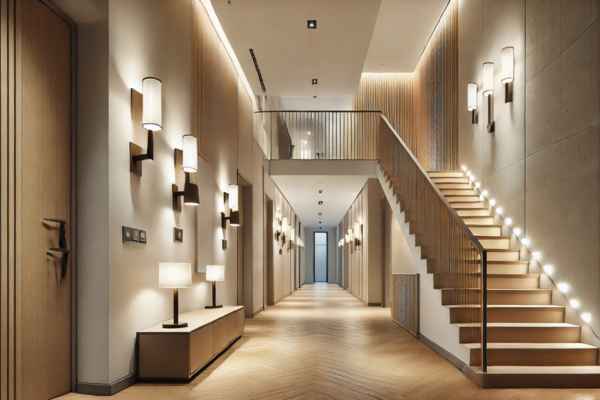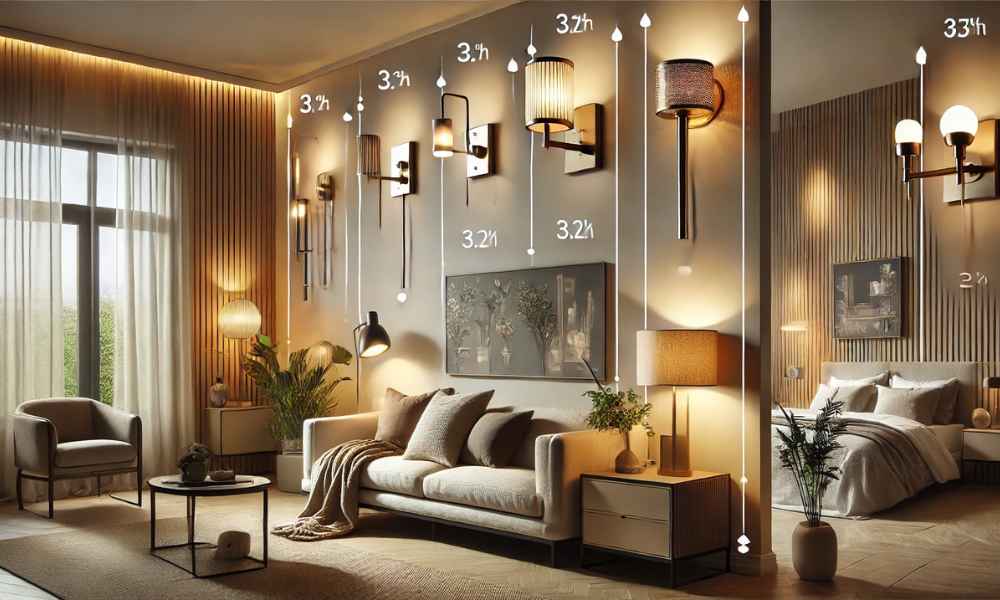Lighting plays an essential role in setting the ambiance of a room, and wall sconces are a stylish yet functional choice for illuminating spaces. Whether enhancing a cozy reading nook or providing flattering vanity lighting, the placement of wall sconce directly impacts their effectiveness. One of the most common questions homeowners and decorators ask is: How High To Hang A Wall Sconce be mounted? The answer varies based on room type, function, and design preferences. This guide will help you determine the optimal sconce height to ensure both aesthetics and practicality.
Understanding Wall Sconces
Wall sconces are versatile lighting fixtures mounted directly on walls, serving as both decorative and functional elements. They can provide ambient, task, or accent lighting, making them suitable for a variety of applications. Available in a wide range of styles, from sleek modern designs to intricate vintage fixtures, sconce can complement any interior decor. Their adaptability makes them a popular choice for homeowners looking to enhance lighting without the need for large ceiling fixtures.
The Golden Rule: Standard Height for Wall Sconces
A widely accepted standard for wall sconce height is between 60 to 72 inches from the floor. However, the most crucial factor is ensuring that the light source remains at or just above eye level to avoid glare and shadows.
- Living Room & Hallways: Typically, sconces are placed around 66 inches from the floor, providing balanced illumination without overwhelming the space.
- Bathroom Vanity Areas: Sconces should be installed between 65 and 70 inches from the floor, with 36 to 40 inches of spacing between paired sconces for even facial illumination.
- Bedroom Lighting: When placed beside the bed, sconces should be 48 to 60 inches from the floor, depending on bed height and the desired reach for reading lights.
Factors That Influence Sconce Placement
Several variables affect the ideal height and positioning of wall sconces. Consider the following when installing them in your home:
Room Functionality
Each room serves a unique purpose, which influences where sconce should be installed. For example, a sconce in a dining area should emit a warm, inviting glow, while a hallway sconce should focus on providing safe passage without being too harsh.
Eye Level Considerations
Proper placement ensures that sconces do not create harsh shadows or excessive glare. A good rule of thumb is to position the sconce’s bulb 5.5 to 6 feet from the floor in spaces where people frequently walk past.
Ceiling Height and Room Proportions
- In rooms with standard 8-foot ceilings, placing sconces around 66 inches from the floor is ideal.
- For higher ceilings (9 feet and above), sconces can be positioned slightly higher, between 68 and 72 inches, to maintain proportion.
- In low-ceiling spaces, sconce should be mounted slightly lower to create an illusion of height without overwhelming the walls.
Furniture Placement and Focal Points
Wall sconces often complement furniture arrangements, requiring thoughtful placement. For example:
- If placed above a sofa or seating area, ensure they do not obstruct headspace.
- In hallways and staircases, sconce should be spaced 6 to 8 feet apart for balanced illumination.
- For bedroom reading sconces, they should be mounted slightly above shoulder level when seated for optimal light direction.
Wall Sconce Height in Different Rooms
Determining how high to hang a wall sconce, it’s essential to consider the specific function of the room. Each space demands a unique lighting approach to optimize both aesthetics and functionality. Whether it’s accentuating artwork, providing reading light, or creating ambient warmth, the correct sconce height can make all the difference.
Living Room Lighting: Making a Statement Without Overpowering

In the living room, wall sconce often serve as accent lighting, adding warmth and depth to the overall decor. The ideal height to hang a sconce in this space is typically 60 to 66 inches from the floor to the center of the fixture. This placement ensures the light is at eye level for most people, creating a cozy, inviting atmosphere without harsh glare. When flanking a fireplace or framing a large piece of art, consider the visual balance. If your ceilings are higher than 9 feet, you can mount the sconces a bit higher to maintain proportion. Additionally, ensure they complement the natural sightline, enhancing the room’s focal points without overwhelming the design.
Bedroom Sconces: Perfect Placement for Reading Lights

Bedroom sconces are popular as bedside reading lights, offering a sleek alternative to traditional table lamps. The key to perfect placement is functionality—ensuring the light is convenient to reach while providing focused illumination. Typically, sconce should be installed between 48 and 60 inches from the floor, depending on the bed’s height. For optimal reading comfort, the light source should be about 20 inches above the top of the mattress. If the sconce has an adjustable arm, you have more flexibility in positioning, allowing for personalized lighting angles. Also, consider the switch placement—mount it within easy reach so you don’t have to stretch or get out of bed to turn the light on or off.
Bathroom Vanity Lights: Sconce Height for the Best Reflection

Proper sconce placement in the bathroom can significantly impact your daily grooming routine. For vanity lighting, sconces are best positioned on either side of the mirror rather than above it. This side placement reduces shadows on the face, providing even, flattering illumination. The ideal height is around 65 to 70 inches from the floor, with sconces mounted 36 to 40 inches apart to frame the mirror effectively. The goal is to have the light source at eye level, which is approximately 60 to 65 inches for most adults. This placement helps eliminate harsh shadows, making tasks like shaving or applying makeup much easier. For double vanities, ensure each sink has its own set of sconce to maintain balanced lighting.
Hallways and Staircases: Lighting the Way Safely and Stylishly

In hallways and staircases, sconces serve both functional and decorative purposes, providing safe passage while enhancing architectural interest. The recommended height for hallway sconce is typically 60 to 72 inches from the floor, depending on ceiling height. For staircases, adjust the placement to follow the incline, maintaining consistent spacing along the wall. For long hallways, sconces should be spaced 6 to 8 feet apart to ensure even light distribution without creating dark patches. If the hallway has low ceilings, consider installing sconces slightly lower to avoid making the space feel cramped. Always prioritize safety—ensure the fixtures don’t protrude too far, posing a hazard in narrow spaces.
Dining Rooms: Setting the Right Mood with Proper Placement

In dining rooms, sconces are all about creating ambiance. They should complement the chandelier or pendant lights, adding layers of soft, diffused light. The ideal height for dining room sconce is between 60 and 72 inches from the floor, with placement adjusted based on the room’s size and ceiling height. When flanking a buffet or sideboard, sconce should be positioned about 6 inches above the furniture piece to draw attention without overwhelming the decor. Dimmable sconce work wonderfully in dining areas, allowing you to adjust the brightness and set the perfect mood for both casual meals and formal gatherings.
Spacing Matters: How Far Apart Should Wall Sconces Be?
While determining how high to hang a wall sconce is crucial, equally important is understanding how far apart they should be. The general rule is to space sconces 6 to 8 feet apart, depending on the room size and lighting needs. In long hallways, this spacing ensures consistent illumination without dark patches. For spaces like bathrooms, sconces flanking a mirror should be placed 36 to 40 inches apart, ideally at eye level. In living rooms or dining areas, balance is key—ensure the spacing complements other light sources like chandeliers or floor lamps, creating a harmonious glow throughout the room.
Sconce Installation Tips for Beginners
Installing wall sconces might seem daunting, but with the right approach, it’s a straightforward DIY task. Start by measuring the desired height—generally, sconces should be hung 60 to 72 inches from the floor to the center of the fixture. Use a level to ensure symmetry, especially if you’re installing multiple sconces. Before drilling, mark the wall with painter’s tape to visualize placement. Always turn off the power at the circuit breaker before handling any electrical components. For added security, anchor the sconces into wall studs or use proper drywall anchors to support their weight.
Common Mistakes to Avoid When Hanging Wall Sconces
Even the most stylish sconces can fall flat if not installed correctly. Here are some common mistakes to steer clear of:
- Hanging Too High or Too Low: This can create awkward shadows and disrupt the room’s visual flow. Aim for eye-level placement for most applications.
- Ignoring Proportions: Sconces that are too large for a small space—or vice versa—can overwhelm the design.
- Poor Spacing: Clustering sconce too closely together can make a room feel cramped, while placing them too far apart may result in uneven lighting.
- Neglecting Function: A sconce should serve both a decorative and functional purpose. Consider the light’s direction and intensity based on the room’s needs.
Design Tips for the Perfect Sconce Placement
Wall sconces are more than light sources—they’re design statements. To achieve the perfect placement:
- Balance the Layout: Pair sconces symmetrically around focal points like mirrors, beds, or artwork.
- Layer the Lighting: Combine sconce with ceiling lights, table lamps, and floor lamps for a dynamic lighting scheme.
- Choose the Right Style: Select sconces that complement your decor, whether modern, rustic, or traditional.
- Adjust Light Direction: Consider up-lighting for ambient glow or down-lighting for task-specific areas like reading nooks.
Troubleshooting: What to Do If Your Sconce Feels Off
Your sconce doesn’t feel quite right, small adjustments can make a big difference.
- Check the Height: If the light is causing glare, it may be hung too high. If shadows dominate, it might be too low.
- Adjust the Angle: Some sconces allow for directional adjustments—tilt them slightly to improve light distribution.
- Reassess Spacing: Inconsistent spacing between multiple sconces can disrupt the room’s balance. Measure and adjust as needed.
If electrical work is involved, don’t hesitate to consult a professional for safe modifications.
Can I Hang Sconces at Different Heights in the Same Room?
Yes, you can hang sconces at different heights in the same room, but it requires careful planning. This approach works well in eclectic or asymmetrical designs, where varied heights create visual interest. For example, in a gallery wall setup, sconce at differing heights can highlight specific artworks. However, maintain a sense of cohesion by ensuring the height variations are intentional and complement the room’s overall design. Using similar sconce styles, finishes, or bulb types can help tie the look together.
What’s the Best Height for Sconces in a Kids’ Room?
In children’s rooms, safety and functionality are top priorities. Wall sconce should be installed out of reach of small hands, typically at least 60 inches from the floor. For reading sconces near beds, consider mounting them slightly lower, around 48 to 54 inches, ensuring they’re easy for older kids to operate. Opt for sconce with cool-to-touch materials and secure wiring. Dimmable sconces or those with adjustable arms offer flexibility as your child grows, adapting to changing needs from nightlights to reading lamps.
How High Should Outdoor Wall Sconces Be Installed?
Outdoor sconces serve both aesthetic and functional roles, providing security and enhancing curb appeal. The ideal height for outdoor sconce is generally 66 to 72 inches from the ground to the center of the fixture. This height ensures sufficient illumination for entryways, patios, or garage doors. For porch lighting, sconce should be positioned slightly above the eye level of the average person. When flanking a doorway, mount them at about 1/4 to 1/3 the height of the door to create a balanced appearance. Ensure outdoor sconces are weather-resistant and positioned to minimize glare while maximizing coverage.
Conclusion
Knowing how high to hang a wall sconce can transform an ordinary space into one that feels thoughtfully designed and perfectly lit. From ensuring proper spacing and safe installation to avoiding common mistakes and considering unique room requirements, every detail matters. Whether you’re brightening a cozy reading nook, adding elegance to a dining room, or enhancing outdoor security, the right sconce placement brings both beauty and functionality to your home. With these tips in mind, you’re ready to create stunning, well-lit spaces that truly shine.
